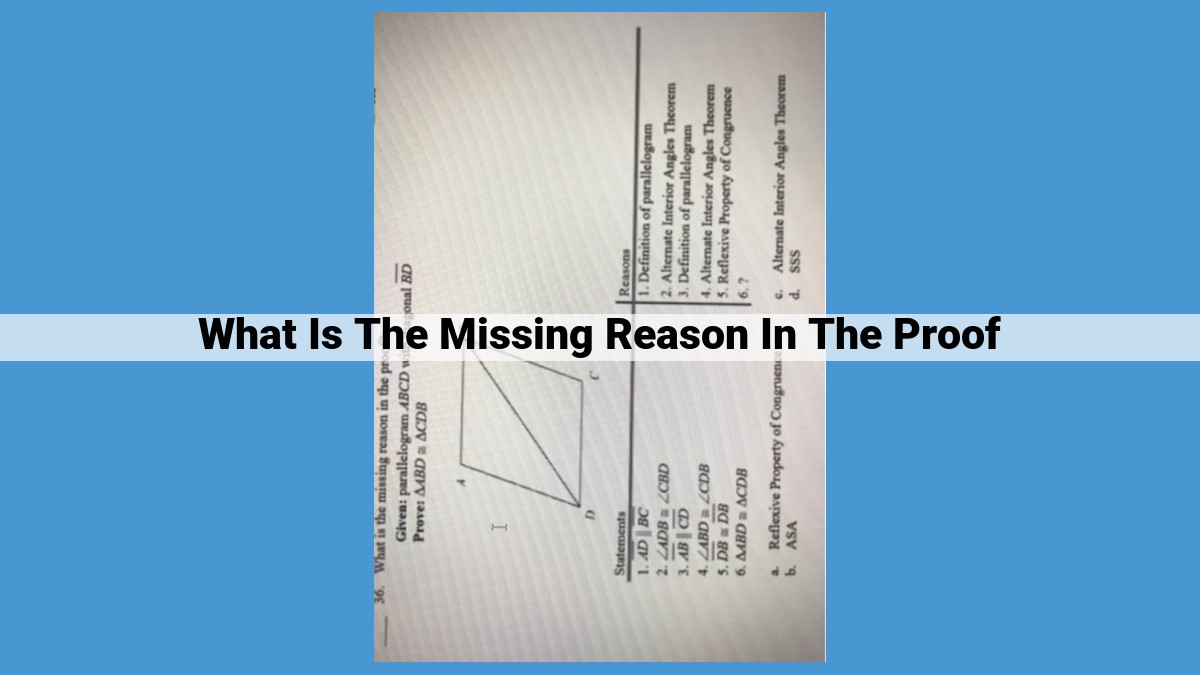In proof by contradiction, unraveling the missing reason involves identifying gaps in logical implication, examining assumptions for validity, and ensuring the use of sound deduction. The proof should trace the missing steps in reasoning, provide evidence for hypotheses, and establish a clear connection between the hypothesis and conclusion. This ensures the completeness and validity of the proof.
Proof by Contradiction: Unraveling the Missing Link
Proof by contradiction is a powerful logical tool that allows us to establish the truth of propositions by assuming their negation leads to an absurdity or contradiction. This technique involves assuming the opposite of the statement we wish to prove and logically deducing a contradiction from this assumption. By showing that the negation leads to something absurd, we can conclude that the original proposition must be true.
An Example:
Let’s say we want to prove the statement: “All prime numbers greater than 2 are odd.“
Assuming its negation: “There exists a prime number greater than 2 that is not odd.“
This assumption logically implies that the prime number must be even. But we know that all even numbers greater than 2 are not prime, because they can be divided evenly by 2.
This leads to a contradiction: assuming the negation of our original statement leads to a violation of a known mathematical fact.
Since the negation leads to an absurdity, we can deduce that the original statement must be true: all prime numbers greater than 2 are indeed odd. Proof by contradiction is a valuable tool in mathematics and logic, allowing us to establish the truth of statements by unraveling the missing links and exposing the contradictions that arise from their negations.
The Role of Assumptions: Filling in the Missing Justification
In the realm of logic, assumptions serve as the building blocks of proofs, providing a solid foundation upon which conclusions are constructed. These unstated truths are crucial to the logical flow of an argument, filling in the gaps between premises and conclusions. However, it’s essential to recognize that assumptions are not mere conjectures; they must be supported by valid reasons to be accepted as true.
Consider the classic example of \”All cats are mammals.\” This statement implies that if an animal is a cat, it must also be a mammal. This implication is valid because it’s based on the assumption that all cats belong to the taxonomic classification of mammals. Without this assumption, the implication would crumble, and the statement would lose its logical coherence.
In any proof, assumptions must be carefully scrutinized and justified to ensure the validity of the argument. They can be derived from various sources, such as established facts, definitions, or axioms. However, regardless of their origin, assumptions need to be well-reasoned and accepted as true by both the arguer and the audience.
In summary, assumptions play a pivotal role in proofs, providing the justification for the logical connection between premises and conclusions. They are the hidden pillars upon which arguments are built, and their validity is crucial to the reliability of the conclusions drawn. By scrutinizing assumptions, we strengthen the foundation of our arguments and ensure that they stand the test of logical reasoning.
Hypothesis: Uncovering the Missing Evidence
In the realm of logical reasoning, a hypothesis serves as a beacon of potential truth, illuminating the path towards an illuminating conclusion. It is not enough to merely propose an idea; to be taken seriously, a hypothesis demands evidence, the lifeblood of credibility.
Like a detective unraveling a mystery, we must meticulously gather clues to support our hypothesis. Evidence can come in various forms: observations, experiments, empirical data. These fragments of information provide the building blocks for a compelling argument. Without a solid foundation, a hypothesis remains a mere suggestion, a whisper in the wind.
Just as a skilled chef carefully measures and blends ingredients, a logical mind judiciously evaluates the quality of evidence. Is it reliable, unbiased, and relevant to the claim? By scrutinizing each piece of evidence, we ensure that our hypothesis rests on a firm and unshakeable foundation.
Furthermore, the evidence must be sufficient to convince a skeptical audience. A lone shred of support, no matter how compelling, is often not enough. Instead, multiple lines of evidence, each independently bolstering the hypothesis, create a robust and convincing case.
In the courtroom of logic, evidence is the witness that can sway the jury, persuading them of the truth or falsity of a claim. By providing compelling evidence to support our hypotheses, we unlock the door to deeper understanding and pave the way for logical conclusions.
